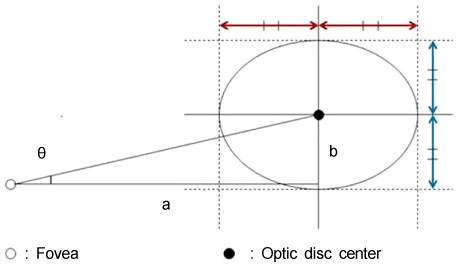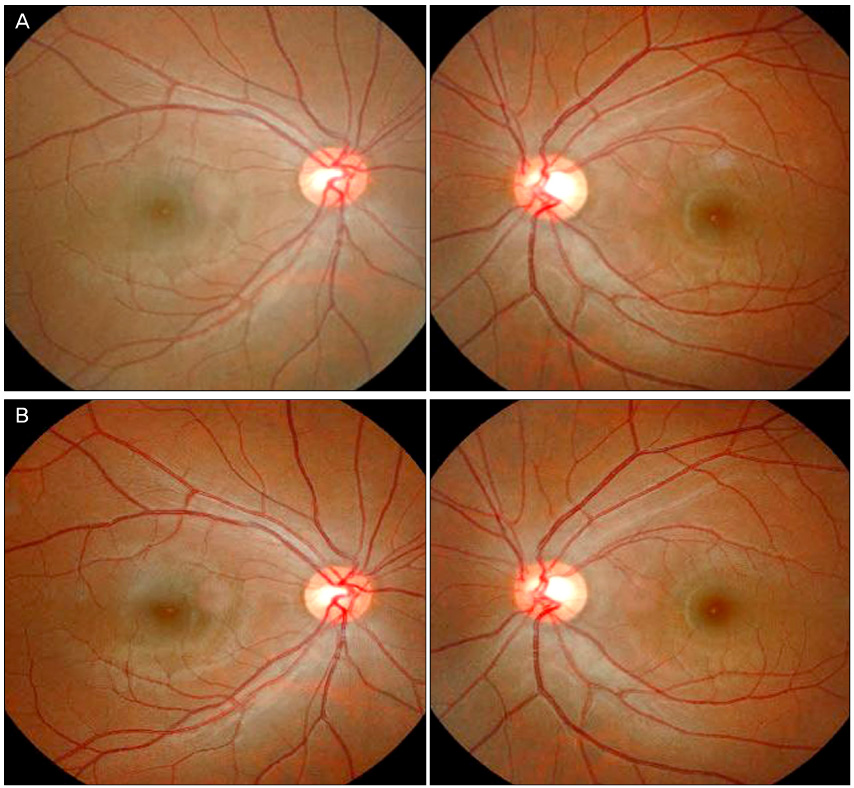J Korean Ophthalmol Soc.
2012 Apr;53(4):565-571.
Surgical Results of Modified Harada-Ito Operation for Excyclotorsion
- Affiliations
-
- 1Department of Ophthalmology, Soonchunhyang University Cheonan Hospital, Soonchunhyang University College of Medicine, Cheonan, Korea. ophdrkim@schmc.ac.kr
Abstract
- PURPOSE
We evaluated the efficacy of the modified Harada-Ito operation for excyclotorsion in acquired superior oblique palsy patients after trauma.
METHODS
This study represents a retrospective review of 10 eyes in 9 patients who were surgically treated for excyclotorsion. Cyclotorsion was measured with the double maddox-rod test and fundus photographies preoperatively and postoperatively.
RESULTS
The median measured change in excyclotorsion before and after the surgery in the primary gaze was reduced from 15.67 +/- 6.00 to 4.78 +/- 3.42 according to fundus photographies and from 12.30 +/- 6.27 to 2.45 +/- 3.73 according to the double maddox-rod test. Subjective and objective changes in excyclotorsion werer not significantly different.
CONCLUSIONS
The Modified Harada-Ito operation is an effective treatment for correcting excyclotorsion. Although not statistically significant, the amount of excyclotorsion on fundus photography is exaggerated. This point should be considered to achieve effective surgery.
Keyword
Figure
Reference
-
1. Von Noorden GK, Campos EC. Binocular Vision and Ocular Motility: Theory and Management of Strabismus. 2002. 6th ed. St. Louis: Mosby;177389–392.2. Fells P. Surgical management of excyclotorsion. Int Ophthalmol Clin. 1976. 16:161–170.3. von Noorden GK. Clinical observations in cyclodeviations. Ophthalmology. 1979. 86:1451–1461.4. Locastro AJ, Kim SJ, Biglan AW. Treatment of cyclodiplopia with the Harada-Ito operation. Am Orthoptic J. 1992. 42:111–119.5. Harada M, Ito Y. Surgical correction of cyclotropia. Jpn J Ophthalmol. 1964. 8:88.6. Bixenman WW, von Noorden GK. Apparent foveal displacement in the normal subject and in cyclotropia. Ophthalmology. 1982. 89:58–62.7. Fells P. Management of paralytic strabismus. Br J Ophthalmol. 1974. 58:255–265.8. Ruttum M, von Noorden GK. The Bagolini striated lens test for cyclotropia. Doc Ophthalmol. 1984. 58:131–139.9. Olivier P, von Noorden GK. Excyclotropia of the nonparetic eye in unilateral superior oblique muscle paralysis. Am J Ophthalmol. 1982. 93:30–33.10. Lee DH, Lee SJ, Park SH. Ocular torsion in normal Korean population. J Korean Ophthalmol Soc. 2004. 45:797–802.11. Park SW. The torsional status of normal Koreans. J Korean Ophthalmol Soc. 2004. 45:1906–1911.12. Lee HJ, Lim KH. The range of ocular torsion in mass screening. J Korean Ophthalmol Soc. 2005. 46:1684–1689.13. Kim EH, Lee SJ, Choi HY. Ocular torsion according to fixation in fundus photograph. J Korean Ophthalmol Soc. 2006. 47:449–454.14. Dieterich M, Brandt T. Ocular torsion and perceived vertical in oculomotor, trochlear and abducens nerve palsies. Brain. 1993. 116(Pt 5):1095–1104.15. Sullivan MJ, Kertesz AE. Peripheral stimulation and human cyclofusional response. Invest Ophthalmol Vis Sci. 1979. 18:1287–1291.16. Ruttum M, von Noorden GK. Adaptation to tilting of the visual environment in cyclotropia. Am J Ophthalmol. 1983. 96:229–237.17. von Noorden GK. Clinical and theoretical aspects of cyclotropia. J Pediatr Ophthalmol Strabismus. 1984. 21:126–132.18. Hooten K, Myers E, Worrall R, Stark L. Cyclovergence: the motor response to cyclodisparity. Albrecht Von Graefes Arch Klin Exp Ophthalmol. 1979. 210:65–68.19. Troia RN, Nelson LB, Calhoun JH, Harley RD. Surgical correction of excyclotropia. Am Orthoptic J. 1985. 35:63–67.20. Metz HS, Lerner H. The adjustable Harada-Ito procedure. Arch Ophthalmol. 1981. 99:624–626.21. Min BM, Kim SY. Effect of Harada - Ito procedure with intraoperative adjustment in excyclotropia. J Korean Ophthalmol Soc. 1994. 35:853–859.22. Yim JH, Min BM, Xu YG. Surgical results of classic Harada-Ito procedure with intraoperative adjustment for excyclotorsion. J Korean Ophthalmol Soc. 2002. 43:2227–2233.23. Ohtsuki H, Hasebe S, Hanabusa K, et al. Intraoperative adjustable suture surgery for bilateral superior oblique palsy. Ophthalmology. 1994. 101:188–193.24. Ohtsuki H, Shiraga F, Morizane Y, et al. Transposition of the anterior superior oblique insertion as a treatment for excyclotorsion induced from limited macular translocation. Am J Ophthalmol. 2004. 137:125–134.
- Full Text Links
- Actions
-
Cited
- CITED
-
- Close
- Share
- Similar articles
-
- Two Cases of Correction of Excyclotorsion Remained after Harada-Ito Procedure
- Modified Harada-Ito Procedure with Intraoperative Adjustable Sutures Using a Mendez Ring for Excyclotorsion
- Surgical Outcomes of Nonadjustable Modified Harada-Ito Surgery
- Surgical Results of Classic Harada-Ito Procedure with Intraoperative Adjustment for Excyclotorsion
- Two Cases of Excyclotropia in Superior Oblique Palsy Treated with Barada-Ito Operation



